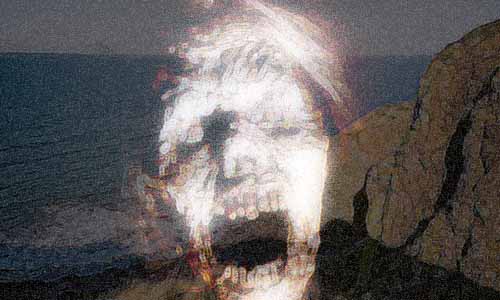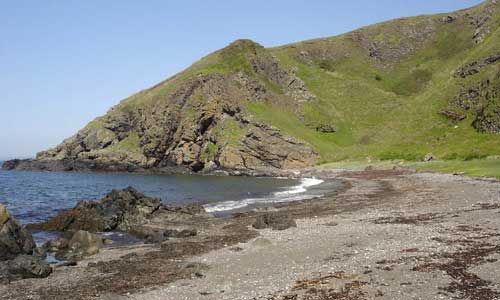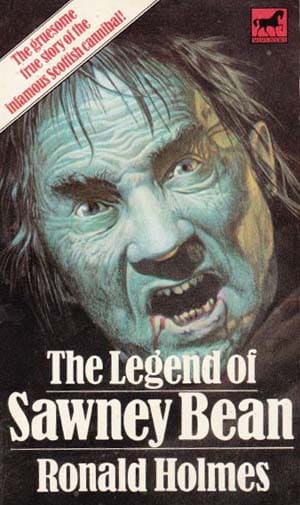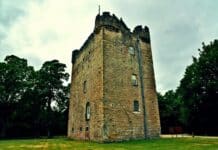Was Sawney Bean the Scottish cannibal real or just folklore? DAVID SAUNDERSON takes at look…

SAWNEY Bean the infamous Scottish cannibal lived in a cave just outside the South Ayrshire village of Girvan where my Mum was born. His gruesome murder and robbery happened mere miles from the area my family has lived for centuries.
Come to think of it, my ancestors may have known or been one of Sawney Bean’s victims. Better still, maybe they were part of the local mob that hunted down this murderous clan. All this depends, of course, whether Bean actually existed and is not just an elaborate bogeyman story.
I’m heading for Scotland this Christmas. It will be the first time I’ll be in Girvan for eight years, so I was looking at the local Girvan Online website today refreshing my memory about the fine little toon. There’s a section on the website about local history and it got me thinking about Sawney Bean.
Who was Sawney Bean, head of murderous clan?
Sawney Bean was the patriarch of an incestuous clan of cannibals who lived in a cave on the coast between Girvan and Ballantrae sometime in the 15th or 16th Centuries or earlier. The tale goes that Bean and his wife “Black Agnes” bred a hoard of 14 children and 32 grandchildren through incest and survived by robbing, killing and eating passing travellers. The freaks lived in the cave for 25 years murdering over 1000 poor souls before being caught, dragged off to Edinburgh and executed.

Unfortunately, or fortunately depending on how you look at it, there doesn’t appear to be a whole lot of evidence whether Bean and his clan actually existed though. The lack of consistency in story and court documents means Bean might little be more than just a fictitious bogeyman.
Sean Thomas writes in the Fortean Times article “In Search of Sawney Bean” back in April 2005:
From broadsheet to broadsheet, the precise dating of Sawney Bean’s reign of anthropophagic terror varies wildly: sometimes the atrocities occurred during the reign of James VI, or the reign of James I more than 150 years before. Other versions claim the Beans thrived “hundreds of years ago” – which could place the murders back in the days of Bruce, or even Macbeth.”
Leaving aside whether the story is not just an urban legend, I was surprised to read about a “legend” of the Hairy Tree – supposedly planted by one of Bean’s daughters in the main street of Girvan – on the Girvan Online Website.
I make no claims about being an expert about a town I have never lived and only visited a few times. But having Girvan-born mother with a propensity for murder mysteries and dark history, I find it amazing that I have never heard of this “Hairy Tree” if it was a well-known local legend.
This is what the Wikipedia Page on Girvan says about the subject:
Historically, Girvan was significant as the home of the Hairy Tree. According to legend, the Hairy Tree was planted by Sawney Bean’s eldest daughter in the town’s Dalrymple Street. However, when her family was arrested, the daughter was implicated in their incestuous and cannibalistic activities and was hanged by locals from the bough of the tree she herself planted. According to local legend, one can hear the sound of a swinging corpse while standing beneath its boughs. The Hairy Tree’s whereabouts are currently unknown, but two high profile campaigns have been launched to relocate it. The Girvan Online website is running a campaign which was started by local investigative journalist and horoscope writer Andrew Penguin.”
The Girvan Online website has pages and pages of comments by people discussing the issue of The Hairy Tree. A quick read of it indicates that most locals, and especially the older ones, have never heard of the tree. Having Scotland’s most infamous bogeyman on your doorstep means the people of Girvan (pop. 7000) are well-versed in the tale of Bean.
I will ask a few people when I’m in Girvan at Christmastime to see what they say. I spoke to my Mum about it on the phone today and she said she had never heard of The Hairy Tree. She did make a good point, though. If the tree did exist on Dalrymple Street it would have been the south end, on the outskirts of town near the Toll, where people used to be hanged, not in the middle of town.
It does seem strange to me that Bean’s daughter – a woman who was on the run from authorities – would dabble in horticulture in the main street of Girvan. And do you really think townsfolk back in the day would not have cut down a tree with such murderous stigma attached? Inbred serial killers don’t usually instil a lot of civic pride in their local communities (other than in Whitechapel, but that is another story).
And the biggest inconsistency – how long does it take for a tree to be planted before you can hang someone from it? It all sounds like tripe really.
Bean the cannibal may be fusion of thrilling history, crime stories and urban legend but that doesn’t really matter. The historic tale lives on in the wealth of mutant hillbilly cannibal films like Texas Chainsaw Massacre and The Hills Have Eyes. It’s all good fun.
The fact is it is a gripping, spooky tale and you can certainly visit the cave where he and his incestuous hoard supposedly lived long, long ago – chomping down on poor travellers.
How to visit Sawney Bean’s Cave
There is a car park at Bennane Head, eight miles south of Girvan and two miles north of Ballantrae. About 150 feet below the car park is a cave that is believed to have been the home of the Bean clan. The cave is supposed to run almost a mile into the hillside but it is very hard to get to, especially at high tide.
AFTERTHOUGHT: Why do they always portray cannibals as being covered in blood, gnawing on an arm or leg? While they might be crazed, surely they cook their food before they eat it!
The Hairy Tree Girvan Update
Since I wrote this article, I have ventured to Girvan to visit family for Christmas. There, I did a small investigation into the Hairy Tree. By no means exhaustive, I think it proves my point.
I spoke to three people who have lived in Girvan all their lives and their families lived in Girvan all their lives (Yes, they are my relatives.) So anyway, they had never heard of the Hairy Tree.
Alex, my grandmother’s cousin, who is a 91 years old ex-fisherman/labourer in the seaside village, said he had only heard of the Hairy Tree rumour from the newspaper in the past couple of months. He’d always known about Bean (which he had always thought was not true in the first place but only a legend) but the Hairy Tree was news to him.
Now, Rita and Jimmy, my mum’s cousin and her husband, are in their 80s, and they have never heard of the Hairy Tree either. They couldn’t even imagine where there would be a tree in Dalrymple Street. Maybe, Henrietta St, but not Dalrymple.
These three people have lived in Girvan all their lives and their direct ancestors have lived in the region since at least the 1700s. They are related to me, but not each other – so they don’t particularly know each other. They live in different parts of town and run in different circles. They have worked in various industries, factories, businesses and all over the area and have never come across anyone who has ever said anything about the Hairy Tree.
The investigation sample is small, I grant you, but it is indicative.
Whether Bean ever existed is not the issue. I am saying that the Hairy Tree is only a recent rumour that has been invented by or for the internet.
With all due respect to those promoting the Hairy Tree – if elderly people in Girvan do not know about the Hairy Tree, it sounds like rubbish to me!
Comment: The Legend of Sawney Bean, please make it true!
Guest writer KATRINA SAUNDERSON dusts off an old copy of Ronald Holmes’ book The Legend of Sawney Bean and is horrified by what she discovered – the Scottish cannibal may never have existed!
Sawney Bean and his family lived in a cave on the south west coast of Scotland.
Over the course of many years, Bean and his family murdered and ate hundreds of people. The monstrosity of their cannibalism was only overshadowed by their rampant acts of incest, which saw many inbred children born to the clan.
When Bean and his kin were finally caught and tried for their crimes, all of them – the men, woman and children – were hanged, drawn and quartered – a gruesome end for a gruesome bunch.
This is the story my Mother told me and I have grown up believing it to be completely true and I have never questioned it.
But reading an old paperback from the 1970s called The Legend of Sawney Bean by Ronald Holmes has lead me to believe that Sawney Bean may only be fiction and that is something I am having a hard time coming to terms with!
My Mother is from Ayrshire in Scotland and the story of Sawney Bean is one she was told and believes to this day to be fact.
The infamous cave the cannibals lived in is only a few miles down the coastal road from her home village of Girvan, where the locals also believe these crimes happened not too long ago.
In his novel The Legend of Sawney Bean, author Ronald Holmes questions the reality of the story and examines how the legend began.
Holmes dissects and analyses the different facets of the tale using Celtic history and mythology, anthropology and geology.
After recounting the story, Holmes traces the history of the published story and looks at how legends begin including the legend of Bloody Baker.
Based on the written description of the cave, geology and archaeology are used to try to discover the cave’s location.
Real or just a folktale?
The reputation of the wild men of Galloway as savages and pre-historic cannibalism are explored and used to explain the legend of Sawney Bean.
As well as looking at the Sawney Bean case, he also examines a number of different Celtic legends and links the similarities to Sawney Bean.
The author gives a compelling argument that this infamous criminal family never actually existed.
This book is a fascinating read, while some of the content is quite disturbing the majority of the content is about Celtic and English history and folklores, including ogres, vampires and the Galloway tale of the Murder Hole.
I have mixed feelings after reading this novel, while I found it interesting and enjoyed the novel I felt a little shell shocked, after all I have spent my life believing these things actually happened.
Even though I should be relieved that these terrible crimes never occurred I feel slightly disappointed and don’t want to believe that it never happened.
I know that it sounds terrible but I still have some hope in my heart that there was an inbred family of murderers who ate their victims. Maybe if I’m lucky, they might have actually ate some relatives of mine.
Tour of Sawney Bean’s Cave
KATRINA SAUNDERSON loves zombies, Buffy the Vampire Slayer, playing XBox and Sawmey Bean, apparently, a little too much, if this article is anything to go by.









James VI of Scotland is the same person as James I of England.
Yes, but the text is referring to the King James’ as they pertain to Scotland. The James I mentioned here is the one killed in 1437, not the one Queen Elizabeth I ordained as her successor.
You hope that this happened and they had victims? You sick fuck.
My mother’s maiden name is Bean and she was able to trace her heritage back to Scotland… We never knew about this though. Weird stuff!
You can’t even spell boogeyman. Moron.
Bogeyman can be spelt in different ways. Thanks for commenting on this story.